
An oast, oast house or hop kiln is a building designed for kilning (drying) hops as part of the brewing process. They can be found in most hop-growing areas and are often good examples of vernacular architecture. Many redundant oasts have been converted into houses. The names oast and oast house are used interchangeably in Kent and Sussex. In Surrey, Hampshire, Herefordshire and Worcestershire they are called hop kilns.

Wincheap is a road and suburb in Canterbury, Kent, England. The road forms part of the A28 road, stretching for around 1 mile (1.6 km) from the city wall, close by Canterbury East railway station, to the over-crossing of the A2 and the parish of Thanington.

The King William Ale House is a historic public house situated on King Street in Bristol, England. It dates from 1670 and was originally part of a row of three houses. The three have been designated by English Heritage as a grade II* listed building since 8 January 1959. It includes a mixture of 17th-century and 18th-century features, but currently serves as a public house owned and operated by Samuel Smith Old Brewery.
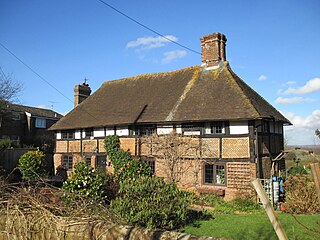
Blackstone is a hamlet in the civil parish of Woodmancote and the Horsham district of West Sussex, England. Blackstone is significant for its listed 17th- and 18th-century houses and cottages.

Chevington is a village and civil parish in the West Suffolk district of Suffolk in East Anglia, England. Located around 10 km south-west of Bury St Edmunds, in 2005 its population was 630, reducing to 602 at the 2011 Census. The parish also contains the hamlets of Broad Green and Tan Office Green.

The Fountain Inn is a 16th-century public house in the village of Ashurst, in the Horsham district of West Sussex, England. After a period as a farmhouse, it was converted into the village inn and was extended and given a Georgian façade in the 18th century. English Heritage has listed the building at Grade II for its architectural and historical importance.

Mathematical tiles are tiles which were used extensively as a building material in the southeastern counties of England—especially East Sussex and Kent—in the 18th and early 19th centuries. They were laid on the exterior of timber-framed buildings as an alternative to brickwork, which their appearance closely resembled. A distinctive black variety with a glazed surface was used on many buildings in Brighton from about 1760 onwards, and is considered a characteristic feature of the town's early architecture. Although the brick tax (1784–1850) was formerly thought to have encouraged use of mathematical tiles, in fact the tiles were subject to the same tax.
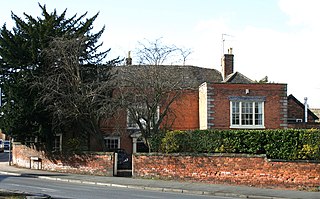
The Rookery, or 125 Hospital Street, is a substantial Georgian townhouse in Nantwich, Cheshire, England. It is at the end of Hospital Street, on the north side, at the junction with Millstone Lane. The existing building dates from the mid-18th century and is listed at grade II; English Heritage describes it as "good" in the listing. Nikolaus Pevsner describes it as "square and stately." It incorporates an earlier timber-framed house at the rear, which probably dates from the late 16th or early 17th century.

The Stag Inn is a public house in the Old Town area of Hastings, a port and seaside resort in East Sussex, England. One of many ancient buildings on All Saints Street, the 16th-century timber-framed inn was refronted in the 18th century, but many of its original features remain. The preserved bodies of two smoke-blackened mummified cats have been displayed on a wall since their discovery in the 19th century; witchcraft has been suggested as an explanation for this "grisly sight". The inn, which claims to be Hastings' oldest surviving pub, is operated as a tied house by the Shepherd Neame Brewery, and has been listed at Grade II by English Heritage for its architectural and historical importance.
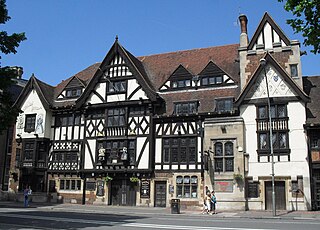
The King and Queen is a pub in the seaside resort of Brighton, part of the city of Brighton and Hove. The present building, a "striking" architectural "pantomime" by the prolific local firm Clayton & Black, dates from the 1930s, but a pub of this name has stood on the site since 1860—making it one of the first developments beyond the boundaries of the ancient village. This 18th-century pub was, in turn, converted from a former farmhouse. Built using materials characteristic of 16th-century Vernacular architecture, the pub is in the Mock Tudor style and has a wide range of extravagant decorative features inside and outside—contrasting with the simple design of the neighbouring offices at 20–22 Marlborough Place, designed a year later. English Heritage has listed the pub at Grade II for its architectural and historical importance.

The hall house is a type of vernacular house traditional in many parts of England, Wales, Ireland and lowland Scotland, as well as northern Europe, during the Middle Ages, centring on a hall. Usually timber-framed, some high status examples were built in stone.

The Bell Inn is a pub at the village of Aldworth, in the English county of West Berkshire. It won CAMRA's National Pub of the Year in 1990, and received the accolade again for 2019. It is a Grade II listed building and is the only pub in Berkshire with a Grade II listed interior. It is also on the Campaign for Real Ale's National Inventory of Historic Pub Interiors.
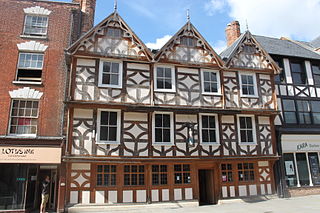
Robert Raikes' House is an historic 16th century timber-framed town house at 36-38 Southgate Street, Gloucester. It is now used as a public house called the Robert Raikes Inn.

The Eclipse Inn is a public house at 25 The Square in the city of Winchester in Hampshire, England. It has been listed Grade II on the National Heritage List for England (NHLE) since January 1974. The building dates from the 16th century and was formerly the rectory of St Lawrence Church. The name of the pub derives from its siting opposite the Sun Inn.

Sir Thomas Herbert's House, often known as Herbert House, is a Grade I listed building in York, dating from the 16th and 17th centuries.

The Blue Bell is a historic pub in the city centre of York, England. The pub lies on the south-west side of Fossgate.
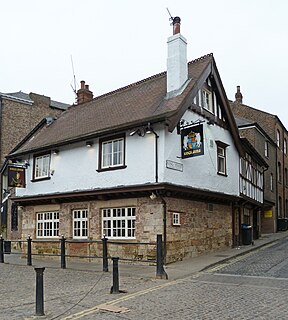
The Kings Arms is a pub lying by the River Ouse in the city centre of York, in England.

The Red Lion is a pub in the city centre of York, in England.
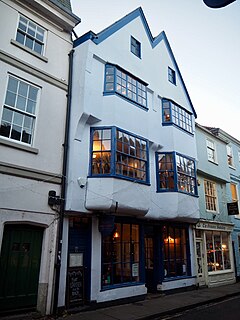
The Eagle & Child is a pub on High Petergate, in the city centre of York, in England.

77 Walmgate is a timber framed building in the city centre of York, in England.




















